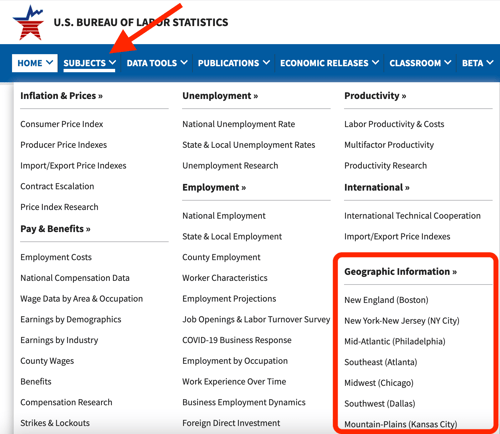B2B competitive analysis is the process of critically assessing your company (or business unit) in relation to one or more competitors. Broadly speaking, the objective is to identify opportunities and/or threats and take action accordingly.
We should emphasize: That is a very broad description. As we’ll discuss throughout this post, B2B companies can employ competitive analysis in a host of unique ways.
To make this point a bit more concrete, here’s a list—far from exhaustive—of some of the specific reasons a company like yours may employ competitive analysis:
- To prioritize product development and acquisition initiatives
- To determine which marketing channels are most worthy of investment
- To help sales and support reps more effectively position your solution
This leads us to our first—and perhaps most critical—takeaway: Competitive analysis can and should be employed in service to all kinds of stakeholders. Your company’s products, campaigns, value propositions—none of these things exist in a vacuum. Accordingly, everyone across your organization is better equipped to do their job effectively and confidently when they’re empowered with competitive insights.
Now, let’s discuss the five steps you should follow to conduct a successful competitive analysis:
- Determine your goal and success metrics
- Collect data
- Draw conclusions and establish the so what
- Deliver insights to your stakeholder(s)
- Reflect, gather feedback, and iterate accordingly

5 steps to a successful B2B competitive analysis
For clarity, we’re going to assume that you’re conducting a competitive analysis because you’ve been asked to do so by a specific stakeholder (or stakeholder group). If you’re at a company that lacks a formal competitive intelligence function, this may be a one-off request; if you’re at a company with a formal competitive intelligence function, this may be an ongoing responsibility. Regardless, what’s important is that there’s a defined audience in mind.
1. Determine your goal & success metrics
If you’re wondering why we went out of our way to issue that disclaimer, this is why: Your analysis needs a goal, and that goal needs to align with whatever it is your stakeholder is trying to achieve. In other words, before you do anything, you and your stakeholder need to be crystal clear about why this request is being made in the first place.
Let’s say you’re on the marketing team at Sell-EZ (we just made that up), a provider of sales analytics software for large retail chains. One day, you get a Slack message from your sales leader, Annie. She’d like you to dig up some insights on ClearData, a large company that recently steered into your lane and has started popping up in more and more deals.
In this case, the reason for the request is pretty obvious: Annie wants your sales reps to win as many deals as possible, and ClearData is an increasingly frustrating obstacle. As such, the most appropriate goal for your analysis is to elucidate the ways in which your solution is superior to ClearData’s, and the most appropriate success metric is competitive win rate.
Oftentimes, the reason for a competitive analysis request is not this obvious. That’s OK, but we cannot overstate the importance of exceedingly clear communication. Only when the reason for the request is clarified can you set an appropriate goal and corresponding success metrics.
And by the way: Don’t be surprised if you find that there’s no real reason for the request. Just because someone thinks they need an analysis, doesn’t mean they’re ready to actually execute on it. For the sake of your time and sanity, it’s best to nip these ill-conceived requests in the bud.
2. Collect data
One of the major benefits of setting a crystal clear goal is that it’s much easier to figure out what kinds of data you need to collect. If the goal is to determine which pain points the market is leaving unaddressed, you’ll need to do a deep dive into your competitors’ offerings. If the goal is to gain social media visibility relative to Competitor XYZ, you’ll need to get a sense of what they publish and how it performs.
Let’s return to our Sell-EZ example, where the goal is to elucidate the ways in which your solution is superior to ClearData’s. Immediately, a few sources of relevant data come to mind:
- ClearData’s website. Examine the positioning and promotion of their analytics product. Does it seem targeted towards any specific audience? Which pain points and benefits do they emphasize? Are there any crucial features that seem to be missing?
- Media coverage of their expansion into your vertical. Like their website, this should give you a sense of who ClearData is targeting and which pain points and benefits they’re emphasizing.
- Reviews of their solution. As far as you can tell, why do businesses buy ClearData’s solution? What do the positive reviews tend to center around? What do the negative reviews tend to center around?
- Your CRM. The whole reason your sales leader made this competitive analysis request is because ClearData has been popping up in more and more deals. Well, according to your sales reps’ notes, what do prospects and customers have to say about them?
Word to the wise: If you want a searchable database of real-time competitive intel that’s plugged into your company’s CRM and communication channels, request a demo of Crayon.
3. Draw conclusions & establish the so what
At this point, we’ve reached the truly analytical part of the competitive analysis process. You’ve got the relevant datapoints in front of you. When you connect them, what do you see?
Admittedly, connecting competitive datapoints isn’t always a walk in the park. If, for example, you were conducting a high-level analysis of marketing in your industry, and you had collected several performance metrics for a dozen different competitors, you would need to create some visualizations before even attempting to draw a conclusion. (If you’re curious what these visualizations might look like, make sure to check out our post on competitive matrices.)
In the case of our Sell-EZ example, you may not need a formal structure or framework to figure out how, exactly, your solution is superior to theirs. If ease of use is scarcely mentioned on their website and frequently mentioned in the notes of your closed-won deals, then it’s reasonable to conclude that ClearData’s product fails to deliver a smooth user experience.
Everyone, of course, has different preferences and learning styles. There are tried-and-true analytical frameworks that you can employ, but at the end of the day, it’s all about simplifying the task of pulling meaning out of your data. Whether that means creating a line graph, generating a word cloud, or devising a simple categorization system, all that matters is that it works for you.
Well, that’s not all that matters—you still need to establish the so what. Your company has a relatively strong social media presence and middle-of-the-road website traffic. So what? Your closest competitor ships product updates twice as frequently as you do. So what? ClearData fails to deliver a smooth user experience. So what?
Without the so what, your competitive analysis is not only incomplete—it’s ineffectual.
4. Deliver insights to your stakeholder(s)
“Deliver insights to your stakeholders.” That’s an odd way of saying “send an email,” isn’t it?
If something along those lines just flashed across your mind, you’re not alone. Given how much we rely on email—especially those of us in hybrid or fully remote work environments—it makes sense that we’d see it as the natural way to disseminate competitive insights. In fact, according to our State of Competitive Intelligence Report, email is the most common way to disseminate competitive insights.
Is this a bad thing? It depends. If you send a follow-up email after formally presenting your competitive analysis, and there’s a new or updated deliverable attached to said email, that’s acceptable. (Ideally, the deliverable is also accessible via some kind of shared platform.)
However, if you just send an email—no presentation, no deliverable—that’s … not great.
Why? Three major reasons:
- An email can get buried in a matter of hours. This is especially true if you’re delivering insights to an executive stakeholder audience.
- In the absence of some kind of presentation, it’s difficult to construct a narrative. So much of competitive analysis comes down to storytelling—not in the sense that you need to make things up, but in the sense that you need to communicate in an impactful way.
- In the absence of some kind of deliverable, it’s difficult to inspire action. This ties back to our first reason. If someone can’t find your standalone email, they may give up and not put your insights to use. But if they have a deliverable—one that’s easy to access and boiled down to the essentials—they’re far more likely to execute on your analysis.
Returning to our Sell-EZ example, an effective way to deliver your insights would be to (1) walk through them on a call with your sales team, (2) direct your reps to the freshly updated ClearData battlecard, and (3) provide office hours for anyone who wants additional guidance on the execution of your recommendations.
5. Reflect, gather feedback, & iterate accordingly
With each competitive analysis comes an opportunity to learn and grow. But you won’t seize that opportunity unless you take the time to reflect—both individually and with stakeholders.
Questions to consider on your own include:
- Did you address your audience’s needs as thoroughly as possible?
- Were there any gaps or inefficiencies in the data collection process?
- Could you have employed a different method of pulling meaning out of the data?
Questions to ask your stakeholders include:
- Do you now feel more confident in your ability to execute and make decisions?
- Did the scope of our analysis match your needs and expectations?
- Did any of our insights strike you as frivolous, inaccurate, or undercooked?
Of course, the whole point of establishing success metrics at the beginning of this process was to give yourself a way to measure the impact of your analysis. Make sure to keep a close eye on these metrics as time goes on, as they’ll help to indicate what, if anything, can be improved the next time around. If your success metrics are qualitative—confidence, morale, etc.—keeping an eye on them may simply mean maintaining an open dialogue with your stakeholders.
The success metric at the core of our Sell-EZ example is competitive win rate. An increase in this figure would indicate that your sales team, with the help of your analysis, is more effectively positioning your solution against ClearData’s; a plateau or decrease in this figure would indicate that either your insights are failing to resonate or your sales team is failing to employ them. Either way, a closer look would be in order. A commitment to ongoing and informed improvement is one of the hallmarks of companies that thrive in the face of competition.
Crayon’s free competitive analysis template
Ready to compete like you mean it? Eager to analyze your competitive landscape and find opportunities to win in your market? Committed to empowering each of your stakeholders with tailored insights and action items?
Check out Crayon’s free competitive analysis template. With more than 50 editable slides and a bonus Excel supplement, you’ll have everything you need to take your first steps towards a sustainable competitive advantage.

Related Blog Posts
Popular Posts
-
 How to Create a Competitive Matrix (Step-by-Step Guide With Examples + Free Templates)
How to Create a Competitive Matrix (Step-by-Step Guide With Examples + Free Templates)
-
 The 8 Free Market Research Tools and Resources You Need to Know
The 8 Free Market Research Tools and Resources You Need to Know
-
 Sales Battlecards 101: How to Help Your Sellers Leave the Competition In the Dust
Sales Battlecards 101: How to Help Your Sellers Leave the Competition In the Dust
-
 6 Competitive Advantage Examples From the Real World
6 Competitive Advantage Examples From the Real World
-
 How to Measure Product Launch Success: 12 KPIs You Should Be Tracking
How to Measure Product Launch Success: 12 KPIs You Should Be Tracking




